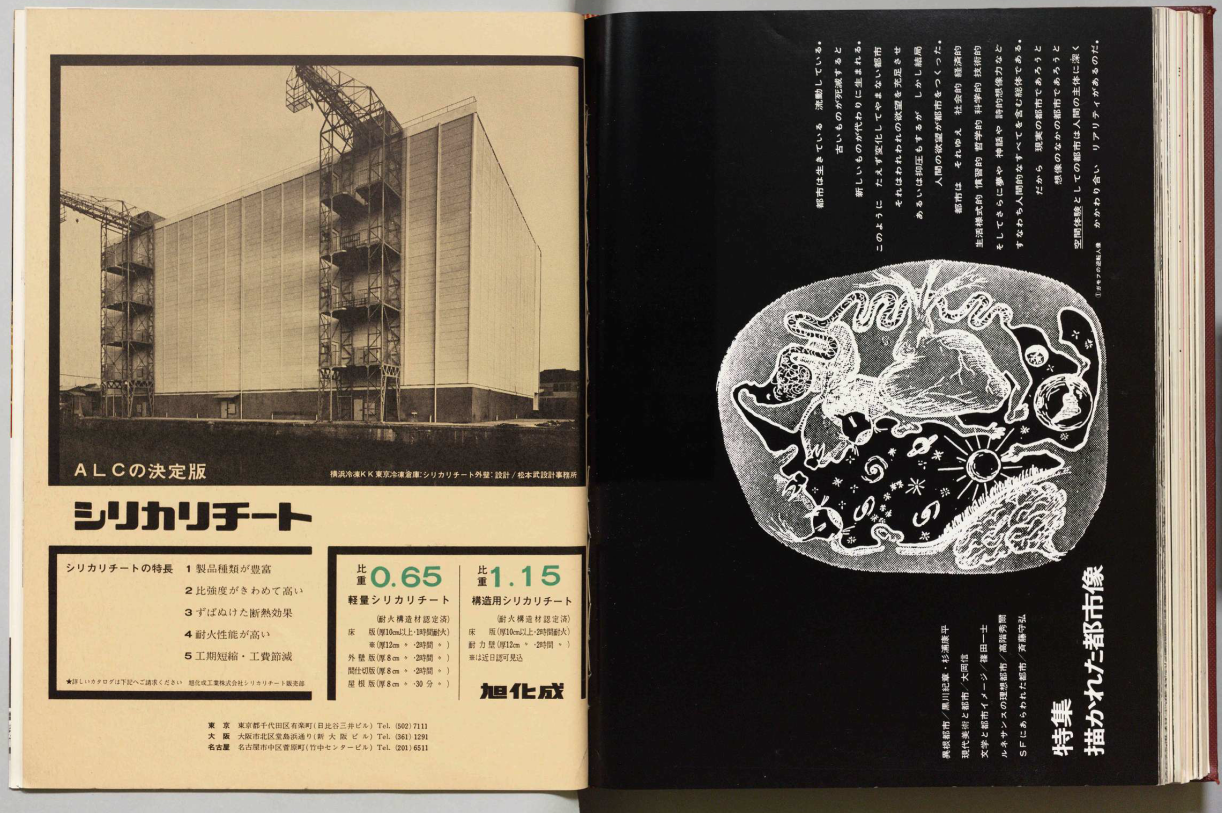Who owns architectural history?
Megacontractors and “media mix” in Japan
Matthew Mullane is an Assistant Professor of the History and Theory of Architecture at Radboud University. He received his PhD from Princeton University and was a postdoctoral fellow at Harvard University and Tokyo College, The University of Tokyo. His forthcoming book, World Observation: Itō Chūta’s Histories of Architecture, offers an alternative origin for global architectural history in 19th-century Japan.

Fig. 1: Excerpt from SD: Space Design no. 11, 1965.
Is architectural history “open”? Institutions like archives, universities, publishers, and foundations certainly determine access to historical materials, but ownership is often fragmented and contested. In Japan, corporate actors play an outsized role. Here general contractors like Kajima Corporation have integrated architectural history into their construction and engineering operations. In addition to building skyscrapers, the Kajima Corporation is also a multimedia conglomerate involved in publishing architecture magazines, funding the translation of important histories, and much more. The singular ownership of these intermedia channels guarantees the predictable transformation of architectural information from the design office to popular media and back again. The financial advantage of owning both construction operations and the historical/theoretical outlets that help determine the appropriateness of certain buildings is obvious. But is it beneficial for everyone? In this presentation, I describe and theorize the corporate structure of architectural history in Japan, focusing on how the “closed” nature of architectural information recursively influences how people interact with architectural history, and how architects design new structures. I introduce this little-known corporate story to theorize the potential “openness” of architectural history in the face of a new challenge: the arrival of corporate interests who control the way we interact with architectural images through artificial intelligence.
To better understand architecture’s volatile media condition in Japan, I would like to begin with Astro Boy. Although anime and architecture seem to be worlds apart, the systems governing their shared intermedia transformation are in fact very similar. Both are highly collaborative and rely on the cooperation of many different industries to successfully design, advertise, and produce a final product. The media theorist Marc Steinberg has described this complex Japanese media ecology as the “anime system,” a network of artists, corporations, and consumers that collaboratively facilitate the movement of characters and assets such as Astro Boy from television to manga and merchandise in order to maximize profit.1 The anime system co-exists with what we can call the “architecture system,” where construction companies and material industries facilitate the transformation of architectural information across print media, film, manga, gallery exhibitions, and back again in a loop of constant transformation. If the anime system trades in cartoon characters, the “architecture system” trades in architects, images, and even theoretical concepts as transformable figures.
The anime and architecture systems both became consolidated in the 1960s. The largest and most influential actor in the architectural sphere was the Kajima Corporation, a still dominant global megacontractor responsible for a huge variety of construction projects, including waste disposal sites, factory complexes, bridges, skyscrapers, arenas, hotels, and apartments. The successful Obayashi Corporation and Shimizu Corporation worked on similar scales, but no other was as media savvy. The Kajima Corporation promoted their services through a “media mix” (media mikkusu), or “advertising that used multiple media forms to deliver an advertising message to potential consumers.”2 This term was introduced by Japanese marketing firms in 1963, the very same year that Kajima launched Kajima Institute Publishing, expanding the company’s reach from construction into information.3
In 1965, Kajima Institute Publishing published the first issue of SD: Space Design, an architecture magazine aimed at a younger generation of designers whose countercultural perspectives were not being reflected in older, more established architectural publications like Shinkenchiku (“New Architecture”). The magazine featured a monthly assortment of contemporary architecture reports, visual essays, art criticism, and translations of important texts on architectural history and theory from around the world. Unlike the many independent “little magazines” of the 1960s and 1970s that distanced architectural history and theory from commerce, the publishers of SD freely combined radical politics and architectural industry.4 Psychedelic photo collages, manifestos, translations, and articles by the well-known Marxist art critic Ichirō Haryū were presented alongside advertisements for new carpeting and lighting fixtures.5 What are often described in the West as avant-garde ideas from a radical periphery were in fact first presented in trade publications. Architectural history and theory had long been sold in books and magazines, but it was now neatly packaged and advertised alongside architectural materials and fixtures as something to be “consumed.”6
The Kajima Corporation’s architectural “media mix” extended to film as well. In 1969, Kajima’s film division, Japan Technology Film Company, financed Dawn of the Skyscraper (Chōkōsō no Akebono).7 The film focused on the construction of Tokyo’s Kasumigaseki Building, a gleaming 36-story office tower constructed by Kajima and hailed as the country’s first glass and steel skyscraper built after the 1963 revision of the Building Standard Law’s prohibition of buildings over 31 meters. What could have been a sober documentary crammed with shots of cranes and concrete mixers is instead a dramatic quasi-fictional retelling of the building’s design and construction with actors cast to play the parts of architects, engineers, and politicians. The film is most famous not for its quality but for Kajima Corporation’s aggressive marketing tactics upon its release. It bought and distributed thousands of tickets, effectively buying out weeks of time at Japanese cinemas.8 The promotional blitz shows what was at stake for the company. Naturally, the Kajima Corporation wanted to advertise their construction expertise, but they also targeted a broader public skeptical of skyscrapers towering over historical landmarks. Dawn of the Skyscraper helped turn the alien building and its many technical and political systems into a familiar film narrative, thus normalizing it for an urban, media-immersed populace.
The Kajima Corporation’s experiments in the architectural media mix continue today. Kajima Institute Publishing is still in operation, and the company’s film group is now Kajima Vision, a digital media promotion and consulting firm that provides websites, films, and other marketing material for a variety of building industries. The Kajima Corporation’s model has also been taken up by other major industrial players, namely those in the tile and toilet manufacturing sector. For example, in 1981, the ceramic tile company Ina Seito opened a gallery space called INA GALLERY, dedicated to exhibitions on architecture, urbanism, ceramics, and design. The gallery’s existence prompted the creation of INAX Publishing to produce catalogs, but its focus soon outgrew the gallery. In 1994, INAX Publishing launched the immensely influential 10+1 magazine, the premier platform for architectural theory and translation for a post-SD generation. The magazine featured profiles on Rem Koolhaas and Jean Nouvel, commissioned translations of Manfredo Tafuri and Anthony Vidler, and spotlighted emerging voices in Japanese architectural history and theory, such as Yatsuka Hajime and Igarashi Tarō.9 Following suit, the global toilet manufacturing juggernaut TOTO launched its own publishing arm in 1989, and, like Ina Seito, opened a gallery space in 1985 called GALLERY·MA (today called TOTO GALLERY·MA). Located above a TOTO showroom displaying the company’s newest bathroom fixtures, the gallery exhibits drawings, models, and installations by key Japanese figures such as Shigeru Ban and SANAA, as well as European firms such as architecten de vylder vinck taillieu. The “gallery-fication” of architectural drawings and models in the 1980s and 1990s expanded the architecture system’s reach to the art world and its elite marketplace.10
How does the “media mix” feed back into contemporary architectural practice? Looking at the recent work of Kengo Kuma & Associates provides some clues. In 2020, the firm completed the Kadokawa Culture Museum, a multi-use facility commissioned by the Kadokawa Corporation that combines a manga library, anime museum, art gallery, cafe, theater, and a floor dedicated to the region’s natural history. The Kadokawa Corporation is a sprawling multimedia empire that extends from traditional publishing to video games and artificial intelligence research. In the 1970s, Kadokawa helped accelerate the industry’s “media mix” by developing assets that operated simultaneously in manga, novels, music, and film, all under an intermedia-minded slogan: “Read it and then watch it? Or watch it and then read it?”11 A recent promotional video made by Kuma’s office celebrates the museum as a continuation of this media mix strategy, and “a completely new type of center for cultural transmission where high culture such as contemporary art, and low culture such as animation, are mixed.”12 The museum building’s facade, material, and orientation stand out among Kuma’s recent oeuvre. Where most of his similarly scaled designs merge perpendicular planes of wood and glass, the museum is opaque, clad in granite, and meant to be explored in the round like a sculpture. Instead of light and transparency, we are faced with an undulating wall of black and white stone, at once resembling the grid of a bookshelf and the black and white panels of a manga removed from its binding and blown up to a monumental scale. Moving around the volume, its silhouette shifts constantly, and any attempt to identify a “front” is frustrated by hidden windows and diminutive entryways obscuring the floor plates and means of circulation. The always shifting nature of the building’s orientation represents the equally mercurial organization of the building’s patron. Where the Kadokawa Corporation’s many ventures are united by a shared corporate hierarchy, the cultural museum is united by an interconnected steel frame. This robust steel skeleton was carried out not by Kuma’s office, but by KAJIMA DESIGN, the Kajima Corporation’s design and construction subsidiary. The meeting of Kajima, Kadokawa, and Kuma in this one project succinctly captures the many intersections of the architecture system and mass media as a single crystalline volume.
Kuma’s relationship with the Kadokawa Corporation continued in 2021 with a totally virtual project, the Kadokawa Dwango Educational Institute VR Campus. In 2016, Kadokawa opened N High School, a secondary school headquartered in Okinawa focusing on online correspondence classes for young people interested in entering the media and entertainment industries. The school offers classes in coding, writing, art, and design with special guest teaching from Kadokawa’s stable of creative industry professionals. N High School now includes 33 campuses across the country, and recently entered the virtual realm with the help of Kengo Kuma and Associates. The firm designed a virtual hub for the school consisting of a series of floating spiral planes suspended in a sky-colored void containing classrooms and common areas. The virtual campus is open to members of the so-called “Premium” education plan, a three-year, VR-based course offered for the equivalent of € 7,200. In response to the alienation experienced by users of online education, N High School advertises the new virtual curriculum as a more immersive environment where students equipped with VR headsets will “learn more intensively and actively.”13
Along with VR, the next frontier of the “media mix” is undoubtedly artificial intelligence. Although AI is often distinguished from other media due to its complexity, secrecy, and ambiguous materiality, its recent adoption by megacontractors in Japan can help us understand it as part of a long-running corporate strategy to effectively own architectural history. The Kajima Corporation has invested in several different AI technologies, including a partnership with ALICE, an AI-assisted tool that generates multiple possible construction schedules based on project contingencies and costs input by the design team. In August of 2023, Kajima also introduced its own AI chat called “Kajima ChatAI” based on Microsoft’s Azure platform. It was made available to over 20,000 employees and will likely be used as the basis of a text-to-image synthesis engine similar to Obayashi Corporation’s “AICorb” announced in July 2023.
Text-to-image AI is often celebrated as helping designers generate unprecedentedly original “futuristic” visions. However, the source imagery is necessarily sourced from existing, historical images, organized into recognizable category trees. In other words, these sorts of technologies are inextricably bound to architectural history, its images, hierarchies, and biases. Mimicking the spiral-shape of Kuma’s floating VR school, AI tools operate in a loop connecting historical source material with inherited expectations of appropriateness. This is a loop I have elsewhere called “algorithmic revivalism.”14 The proprietary nature of most image training sets used in AI text-to-image synthesis suggests that architectural history can indeed be owned, and that it is highly valuable (perhaps a shock to many academic architectural historians!). AI’s unchallenged forward momentum is often justified by being “historically unprecedented,” but it should be considered as part of a media continuum.15 AI’s “closed” nature follows past corporate strategies of controlling architectural history through analog media including magazines, book translations, films, and galleries. Kajima Corporation’s “media mix” suggests that we problematize “openness” as not only a problem of the digital, but also as part of a longstanding contest between architectural history and corporate ownership.
References
- Marc Steinberg, Anime’s Media Mix: Franchising Toys and Characters in Japan (Minneapolis, MN: University of Minnesota Press, 2012), viii-xii. See also Thomas Lamarre, The Anime Ecology: A Genealogy of Television, Animation, and Game Media (Minneapolis, MN: University of Minnesota Press, 2018). ↩︎
- Ibid., 139. The Kajima Corporation also used its publishing firm to produce and disseminate the company’s own history. See for example Kajima Corporation: A Journey Through 140 Years (Kajima kensetsu: hyakuyonjū nen no ayumi), ed. Kajima Institute Publishing Editorial Department (Tokyo, Kajima Institute Publishing, 1980). ↩︎
- Ibid., 138-139. See also Yuriko Furuhata, Climatic Media: Transpacific Experiments in Atmospheric Control (Durham, NC: Duke University Press, 2022), 173-176. ↩︎
- By “little magazines,” I refer to the sorts of designer and student-led publications detailed in Clip, Stamp, Fold: The Radical Architecture of Little Magazines 196X to 197X, eds. Beatriz Colomina and Craig Buckley (Barcelona: Actar Publishers, 2010). ↩︎
- SD: Space Design, no. 1 (Jan., 1965). ↩︎
- Marilyn Ivy, “Critical Texts, Mass Artifacts, The Consumption of Knowledge in Postmodern Japan” in Postmodernism and Japan, eds. Masao Miyoshi and Harry D. Harootunian (Durham, NC: Duke University Press, 1989), 21-46. ↩︎
- Japanese Technology Film Company changed its name to Kajima Film in 1969 and to Kajima Vision in 1989. ↩︎
- Film Almanac (Eiga nenkan), ed. Tsuchiko Takeshi (Tokyo: Jiji tsūshinsha, 1970), 244. See also Alexander Zahlten, The End of Japanese Cinema: Industrial Genres, National Times, and Media Ecologies (Durham, NC: Duke University Press, 2017). ↩︎
- For a full list of issues and contents, see the 10+1 digital archive, https://db.10plus1.jp/. ↩︎
- See Jordan Kaufmann, Drawing on Architecture: The Object of Lines, 1970-1990 (Cambridge, MA: The MIT Press, 2018), 3. ↩︎
- Steinberg, Anime’s Media Mix, 152. ↩︎
- VR KKAA, “Kengo Kuma immersive collection vol. 4 Tokorozawa Sakura Town”, YouTube, August 5, 2022, https://www.youtube.com/watch?v=w49vtAb6ATE. ↩︎
- Kengo Kuma Designs the Learning Tower for the New ‘Premium General Course’ Using the Latest VR Technology Devices, N High School, October 15, 2020, https://nnn.ed.jp/news/blog/archives/11427/. ↩︎
- “Seeing History with Computer Vision: The Architecture of Text-to-Image Synthesis”, proceedings of “Building Data: Architecture, Memory, and New Imaginaries” (TU Delft and Het Nieuwe Instituut, 2022). ↩︎
- This is a quote from Fei-Fei Li, founder of the image training dataset ImageNet. In Kate Crawford, Atlas of AI: Power, Politics, and the Planetary Costs of Artificial Intelligence (New Haven, CT: Yale University Press, 2021), 197. ↩︎











